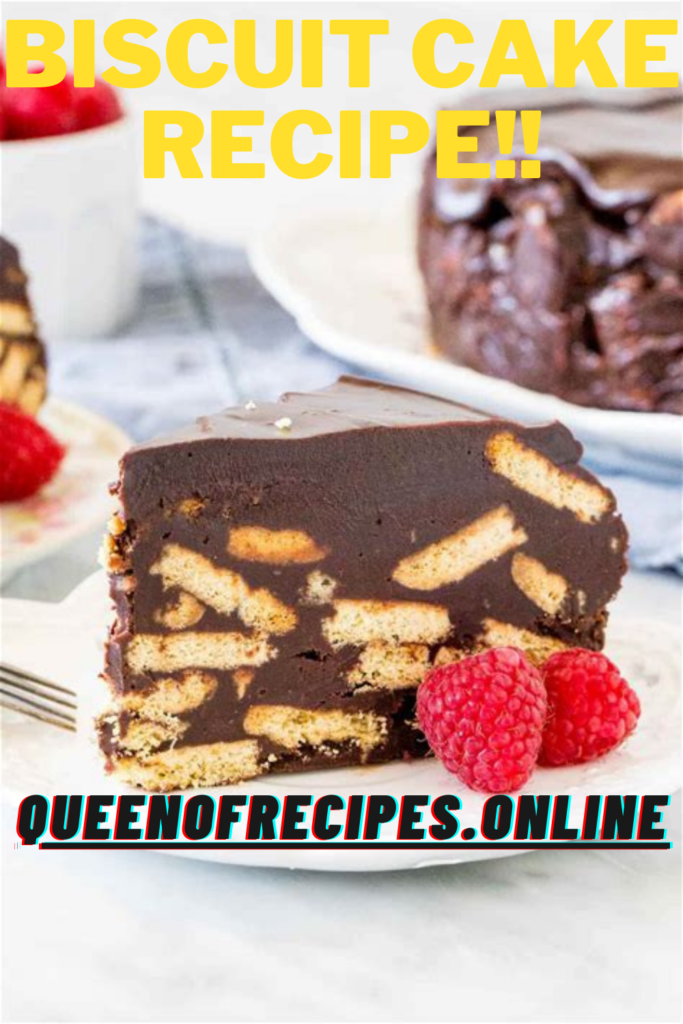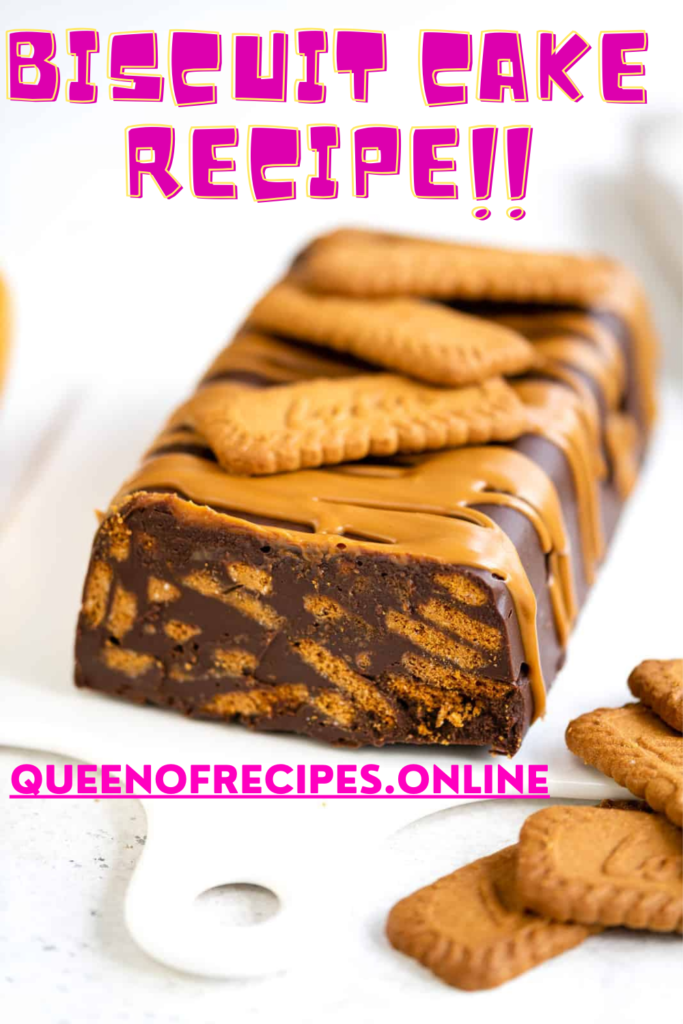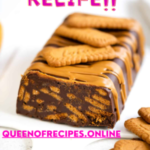Table of Contents
Introduction Biscuit Cake.
Biscuit cake is a delightful and simple dessert that combines the beloved flavors of biscuits and cake into one delightful treat. This no-bake dessert is a popular choice for those looking to satisfy their sweet tooth without the need for extensive baking skills or equipment. It is made by layering biscuits with a creamy filling or frosting, often infused with flavors like chocolate or vanilla. The result is a luscious, chilled dessert that’s perfect for celebrations, potlucks, or just when you’re craving a quick and easy dessert fix.
In this introduction, we’ll explore the world of biscuit cake, its versatility, and how you can easily create this delicious dessert in your own kitchen. Whether you’re a beginner in the world of baking or a seasoned pro, biscuit cake offers a delightful and convenient way to enjoy the flavors of cake with the simplicity of biscuits.
Ingredients:
For the Biscuit Cake:
- 2 packets of tea biscuits (approximately 24-30 biscuits)
- 1 cup milk
- 1/2 cup unsalted butter
- 1/2 cup powdered sugar
- 2-3 tablespoons cocoa powder (adjust to taste)
- 1 teaspoon vanilla extract
- A pinch of salt
For the Chocolate Ganache:
- 1/2 cup heavy cream
- 1/2 cup chocolate chips or chopped chocolate
For Decoration (Optional):
- Crushed nuts (e.g., almonds, walnuts)
- Sprinkles
- Chocolate shavings
Instructions:
1. Preparing the Biscuit Cake:
a. In a saucepan, heat the milk and butter over low heat until the butter melts. Stir to combine.
b. Add the powdered sugar, cocoa powder, vanilla extract, and a pinch of salt to the milk-butter mixture. Mix well until everything is dissolved and the mixture is smooth. Remove from heat and let it cool slightly.
c. Take a rectangular or square dish (approximately 8×8 inches) and line it with parchment paper, leaving some overhang on the sides for easy removal later.
d. Dip each biscuit into the cocoa mixture one by one, ensuring they are coated evenly. Arrange a layer of dipped biscuits on the bottom of the dish. You can break them if needed to fit the shape of the dish.
e. Continue layering dipped biscuits and the cocoa mixture until you use up all the biscuits. The top layer should be the cocoa mixture.
2. Making the Chocolate Ganache:
a. In a microwave-safe bowl or on the stovetop, heat the heavy cream until it’s hot but not boiling.
b. Add the chocolate chips or chopped chocolate to the hot cream. Let it sit for a minute to soften, then stir until you have a smooth and glossy chocolate ganache.
3. Assembling the Cake:
a. Pour the prepared chocolate ganache over the top layer of it spreading it evenly with a spatula.
b. Optionally, sprinkle crushed nuts, chocolate shavings, or colorful sprinkles on top for decoration.
4. Chilling and Setting:
a. Cover the dish with plastic wrap and refrigerate it for at least 3-4 hours, or preferably overnight. This allows the cake to set and the flavors to meld.
5. Serving:
a. Once the biscuit cake is well-set, use the parchment paper overhangs to lift it out of the dish. Place it on a serving platter.
b. Slice and serve your homemade biscuit cake chilled. Enjoy!
This no-bake biscuit cake is a quick and easy dessert that’s perfect for satisfying your sweet cravings. You can get creative with the toppings and even add fruits or flavored extracts to customize the taste to your liking.


Nutritional Value.
The nutritional value of a it can vary depending on the specific ingredients used and the portion size. Below is a general approximation of the nutritional content for a typical serving of biscuit cake:
Calories: A small slice (approximately 100 grams) of biscuit cake can contain around 300-400 calories.
Carbohydrates: Biscuit cake is primarily made from biscuits, which are rich in carbohydrates. A typical serving may contain 40-60 grams of carbohydrates.
Fats: Biscuit cakes often include butter or cream, contributing to their fat content. A serving can contain 15-25 grams of fat.
Sugar: The powdered sugar used in the recipe adds sweetness. A serving might contain 20-40 grams of sugar or more, depending on the recipe.
Protein: Biscuit cakes typically have minimal protein content, with around 2-5 grams per serving.
Fiber: Biscuit cakes are generally low in dietary fiber, providing less than 1-2 grams per serving.
Vitamins and Minerals: Biscuit cakes are not a significant source of vitamins and minerals. Any nutrients present would come from added ingredients like nuts or chocolate.
Sodium: The sodium content can vary based on the type of biscuits used and other ingredients, but it’s typically low to moderate.
It’s important to note that biscuit cakes are a dessert and are often high in calories, sugar, and fat. They are best enjoyed in moderation as an occasional treat rather than as a regular part of a balanced diet. To get a more precise nutritional breakdown, you can use a nutritional calculator or refer to the packaging labels of specific products used in the recipe.
Health Benefits.
Biscuit cake, while undeniably delicious, is not typically associated with significant health benefits due to its high sugar, fat, and calorie content. However, it can provide some minor pleasures and comforts:
- Emotional Well-being: Biscuit cake, like other desserts, can provide emotional satisfaction and comfort, lifting one’s spirits and providing moments of happiness.
- Source of Energy: The carbohydrates and sugars in biscuit cake can provide a quick source of energy when needed, although this should be consumed in moderation.
- Social Enjoyment: Sharing a biscuit cake with friends and family during special occasions or gatherings can contribute to social bonding and enjoyable experiences.
It’s essential to consume biscuit cake in moderation and as an occasional indulgence rather than relying on it for health benefits. For a healthier dessert option, consider incorporating more fruits, nuts, and whole grains into your diet while limiting the intake of sugary and high-fat treats like biscuit cake.
Tips and Tricks.
Here are some tips and tricks for making a delicious biscuit cake:
1. Choose High-Quality Biscuits:
- The quality of the biscuits you use can significantly impact the taste and texture of the cake. Opt for good-quality tea biscuits or cookies that you enjoy eating on their own.
2. Be Creative with Flavors:
- Experiment with different flavors by using flavored biscuits or adding extracts like almond, vanilla, or citrus zest to the chocolate mixture for a unique twist.
3. Biscuit Consistency:
- Dip the biscuits briefly in the liquid mixture to maintain some of their crunchiness. Over-soaking can result in a mushy cake.
4. Layering Technique:
- Create even layers by arranging the dipped biscuits neatly in the dish. This helps in slicing the cake later without crumbling.
5. Customize Toppings:
- Customize the toppings to your liking. You can add crushed nuts, shredded coconut, or colorful sprinkles on top for extra texture and visual appeal.
6. Adjust Sugar and Sweetness:
- Adjust the amount of powdered sugar and cocoa powder to your taste preferences. If you prefer a less sweet cake, reduce the sugar quantity.
7. Ganache Consistency:
- Pay attention to the consistency of the chocolate ganache. You can adjust it by adding more cream if it’s too thick or more chocolate if it’s too thin.
8. Chilling Time:
- Allow the cake to chill in the refrigerator for a sufficient time (at least 3-4 hours or overnight) to set properly and develop its flavors.
9. Slice with a Hot Knife:
- For clean and smooth slices, dip a knife in hot water and wipe it dry before slicing the cake. Repeat this step for each slice.
10. Presentation:
- When serving, dust the cake with cocoa powder, powdered sugar, or a drizzle of melted chocolate for an elegant presentation.
11. Customize the Filling:
- Get creative with the filling by adding layers of whipped cream, fruit preserves, or chocolate chips between the biscuit layers for added flavor and texture.
12. Dietary Modifications:
- You can make biscuit cake to suit dietary restrictions by using gluten-free biscuits, dairy-free milk, and vegan chocolate.
13. Portion Control:
- Since biscuit cake can be quite rich, consider slicing it into smaller portions to prevent overindulgence.
By following these tips and tricks, you can create a biscuit cake that’s not only delicious but also tailored to your preferences and needs. It’s a versatile dessert that allows for creativity and personalization.


Serving Suggestions.
Biscuit cake is a delightful dessert that can be enjoyed on its own or paired with various accompaniments. Here are some serving suggestions to enhance your biscuit cake experience:
- Whipped Cream: Serve each slice of biscuit cake with a dollop of freshly whipped cream. The light and airy texture of whipped cream complements the denser cake.
- Fresh Berries: Garnish the cake with a handful of fresh berries, such as strawberries, raspberries, or blueberries. The natural sweetness and tartness of the berries balance the richness of the cake.
- Vanilla Ice Cream: A scoop of vanilla ice cream alongside a slice of biscuit cake creates a delightful contrast in temperatures and textures.
- Chocolate Sauce: Drizzle warm chocolate sauce over the cake for an extra layer of chocolatey indulgence.
- Coffee or Tea: Enjoy your biscuit cake with a cup of hot coffee or tea. The slightly bitter notes of coffee or the soothing qualities of tea pair well with the sweetness of the cake.
- Milk: A glass of cold milk is a classic accompaniment to biscuit cake, offering a simple and satisfying combination.
- Fruit Compote: Prepare a fruit compote by simmering fruits like apples, pears, or peaches with a touch of sugar and spices. Spoon it over the cake for added flavor.
- Nuts: Chopped nuts, such as almonds, walnuts, or pistachios, sprinkled on top or used as a garnish, add a delightful crunch and nutty flavor.
- Caramel Drizzle: Elevate your biscuit cake with a drizzle of homemade caramel sauce. The sweetness and richness of caramel complement the cake’s flavors.
- Dusting of Cocoa or Powdered Sugar: Lightly dust the cake with cocoa powder or powdered sugar just before serving for an elegant presentation.
- Fruit Yogurt: Serve the cake with a side of fruit-flavored yogurt for a creamy and fruity contrast.
- Mint Leaves: A few fresh mint leaves as a garnish can add a touch of freshness and color to your dessert plate.
- Liqueur: For adult gatherings, you can pair biscuit cake with a complementary liqueur or spirit, such as Baileys Irish Cream or Amaretto.
Feel free to mix and match these serving suggestions based on your preferences and the occasion. Biscuit cake is versatile and can be enjoyed in various ways, making it a versatile dessert option for different tastes and settings.
FAQs.
Can I use any type of biscuits for biscuit cake?



While tea biscuits or plain, mildly sweet biscuits are commonly used for biscuit cakes, you can experiment with different biscuit varieties to suit your taste. Keep in mind that the choice of biscuits will affect the sweetness, texture, and overall flavor of the cake. It’s advisable to select biscuits that complement the flavors you want to achieve in your biscuit cake. Some people enjoy the creativity of trying different biscuit types to create unique and personalized variations of the dessert.
How long does biscuit cake need to chill before serving?



Biscuit cake typically needs to chill in the refrigerator for at least 3-4 hours to set properly and develop its flavors. However, if time allows, it’s even better to refrigerate it overnight. This extended chilling time allows the cake to become firmer, making it easier to slice into neat portions and enhancing the overall taste and texture. So, while you can serve it after a few hours of chilling, the extra patience of waiting overnight is often rewarded with a more delicious result.
What variations can I try with biscuit cake?



There are numerous creative variations you can explore with biscuit cake:
Fruit-Infused: Add fruit purees or chunks between the biscuit layers to create a fruity twist. Bananas, strawberries, or mangoes work well.
Nutty Delight: Incorporate chopped nuts like almonds, walnuts, or pistachios for added crunch and flavor.
Coffee or Mocha Flavor: Infuse coffee or espresso into the liquid mixture for a delightful coffee-flavored biscuit cake.
Caramel Drizzle: Drizzle homemade caramel sauce between the layers or on top for a rich and sweet caramel biscuit cake.
Fruity Syrups: Experiment with flavored syrups like raspberry or orange to add unique fruity notes to your cake.
Citrus Zest: Add zest from citrus fruits like orange or lemon to the cocoa mixture for a zesty, refreshing twist.
Mint Chocolate: Incorporate mint extract or crushed mint candies into the chocolate mixture for a refreshing mint chocolate biscuit cake.
Tropical Twist: Use coconut biscuits and pineapple juice in the mixture for a tropical-flavored biscuit cake.
Layered Fillings: Add layers of flavored cream, fruit preserves, or chocolate chips between the biscuit layers for extra complexity.
Candy Bar Crush: Crush your favorite candy bars and sprinkle them between the layers for a candy-loaded biscuit cake.
Feel free to mix and match these variations to create a biscuit cake that suits your taste preferences and adds a unique twist to this classic dessert.
Why does my biscuit cake turn out too soft or too firm?



The texture of your biscuit cake can vary depending on several factors:
Dipping Time: If you dip the biscuits for too long in the liquid mixture, they may become overly soft. Be sure to dip them briefly to maintain some crunchiness.
Chilling Time: Insufficient chilling time may result in a softer cake, while an extended chill allows it to firm up. Follow the recommended chilling time for the desired texture.
Biscuit Type: The type of biscuits you use can impact the texture. Some biscuits soften more quickly than others when dipped, so experiment to find the right balance for your preferred texture.
Recipe Variations: Different recipes and variations can yield cakes with varying textures. Adjust the recipe to your liking for a softer or firmer result.

